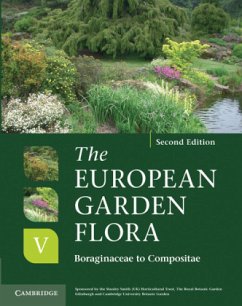The European Garden Flora 5 Volume Hardback Set
A Manual for the Identification of Plants Cultivated in Europe, Both Out-Of-Doors and Under Glass
Herausgegeben von Cullen, James; Knees, Sabina G.; Cubey, H. Suzanne
The European Garden Flora 5 Volume Hardback Set
A Manual for the Identification of Plants Cultivated in Europe, Both Out-Of-Doors and Under Glass
Herausgegeben von Cullen, James; Knees, Sabina G.; Cubey, H. Suzanne
- Broschiertes Buch
- Merkliste
- Auf die Merkliste
- Bewerten Bewerten
- Teilen
- Produkt teilen
- Produkterinnerung
- Produkterinnerung
The European Garden Flora is the definitive manual for the accurate identification of cultivated ornamental flowering plants. Designed to meet the highest scientific standards, the vocabulary has nevertheless been kept as uncomplicated as possible so that the work is fully accessible to the informed gardener as well as the professional botanist. Comprehensive keys are provided at the level of family, genus and species and line diagrams are included to illustrate the important diagnostic features of critical taxa. Reference is made to useful illustrations and taxonomic accounts and a small…mehr
Andere Kunden interessierten sich auch für
![Anaconda Taschenführer Bäume. 70 Arten entdecken und bestimmen - Anaconda Taschenführer Bäume. 70 Arten entdecken und bestimmen -]() Xavier NitschAnaconda Taschenführer Bäume. 70 Arten entdecken und bestimmen -4,95 €
Xavier NitschAnaconda Taschenführer Bäume. 70 Arten entdecken und bestimmen -4,95 €![Proceedings of the Nineteenth European Marine Biology Symposium Proceedings of the Nineteenth European Marine Biology Symposium]() Proceedings of the Nineteenth European Marine Biology Symposium156,99 €
Proceedings of the Nineteenth European Marine Biology Symposium156,99 €![An Essay on the History and Cultivation of the European Olive-Tree An Essay on the History and Cultivation of the European Olive-Tree]() Augustus L. (Augustus Lucas) HillhouAn Essay on the History and Cultivation of the European Olive-Tree27,99 €
Augustus L. (Augustus Lucas) HillhouAn Essay on the History and Cultivation of the European Olive-Tree27,99 €![Hortus Kewensis; Or, a Catalogue of the Plants Cultivated in the Royal Botanic Garden at Kew; Volume 5 Hortus Kewensis; Or, a Catalogue of the Plants Cultivated in the Royal Botanic Garden at Kew; Volume 5]() William Townsend AitonHortus Kewensis; Or, a Catalogue of the Plants Cultivated in the Royal Botanic Garden at Kew; Volume 537,99 €
William Townsend AitonHortus Kewensis; Or, a Catalogue of the Plants Cultivated in the Royal Botanic Garden at Kew; Volume 537,99 €![Paris in Bloom Paris in Bloom]() Georgianna LaneParis in Bloom14,99 €
Georgianna LaneParis in Bloom14,99 €![The Environment and the European Public Sphere The Environment and the European Public Sphere]() Anahita GrisoniThe Environment and the European Public Sphere79,99 €
Anahita GrisoniThe Environment and the European Public Sphere79,99 €![Illustrations of the New Zealand Flora Illustrations of the New Zealand Flora]() Matilda SmithIllustrations of the New Zealand Flora37,99 €
Matilda SmithIllustrations of the New Zealand Flora37,99 €-
-
-
The European Garden Flora is the definitive manual for the accurate identification of cultivated ornamental flowering plants. Designed to meet the highest scientific standards, the vocabulary has nevertheless been kept as uncomplicated as possible so that the work is fully accessible to the informed gardener as well as the professional botanist. Comprehensive keys are provided at the level of family, genus and species and line diagrams are included to illustrate the important diagnostic features of critical taxa. Reference is made to useful illustrations and taxonomic accounts and a small amount of guidance on cultivation is provided for many genera. This new edition has been thoroughly reorganised and revised, bringing it into line with modern taxonomic knowledge. Although European in name, the Flora covers plants cultivated in most areas of the United States and Canada as well as in non-tropical parts of Asia and Australasia.
Produktdetails
- Produktdetails
- Verlag: Cambridge University Press
- 2. Aufl.
- Seitenzahl: 3472
- Erscheinungstermin: 25. August 2011
- Englisch
- Abmessung: 292mm x 233mm x 154mm
- Gewicht: 9700g
- ISBN-13: 9780521761673
- ISBN-10: 0521761670
- Artikelnr.: 33241920
- Herstellerkennzeichnung
- Libri GmbH
- Europaallee 1
- 36244 Bad Hersfeld
- gpsr@libri.de
- Verlag: Cambridge University Press
- 2. Aufl.
- Seitenzahl: 3472
- Erscheinungstermin: 25. August 2011
- Englisch
- Abmessung: 292mm x 233mm x 154mm
- Gewicht: 9700g
- ISBN-13: 9780521761673
- ISBN-10: 0521761670
- Artikelnr.: 33241920
- Herstellerkennzeichnung
- Libri GmbH
- Europaallee 1
- 36244 Bad Hersfeld
- gpsr@libri.de
Cullen, James
James Cullen has been a professional plant taxonomist for over 50 years, working particularly on the classification and identification of plants in cultivation (especially Rhododendron) at Liverpool and Edinburgh Universities, at the Royal Botanic Garden, Edinburgh, and in Cambridge. With the late Dr S. M. Walters, he was the initiator of the first edition of The European Garden Flora and is responsible for two spin-offs, The Orchid Book (1992) and Manual of North European Garden Plants (2001).
Knees, Sabina G.
Sabina Knees is a taxonomist at the Royal Botanic Garden, Edinburgh and although now working on plants of the Middle East, particularly the flora of the Arabian Peninsula and Socotra, she spent over 20 years working as a horticultural taxonomist for the Royal Horticultural Society and the Royal Botanic Garden, Edinburgh and is a founder member of the Horticultural Taxonomy Group (HORTAX). She was editor of The New Plantsman for seven years and worked initiall
Cullen, James§James Cullen has been a professional plant taxonomist for over 50 years, working particularly on the classification and identification of plants in cultivation (especially Rhododendron) at Liverpool and Edinburgh Universities, at the Royal Botanic Garden, Edinburgh, and in Cambridge. With the late Dr S. M. Walters, he was the initiator of the first edition of The European Garden Flora and is responsible for two spin-offs, The Orchid Book (1992) and Manual of North European Garden Plants (2001).
Knees, Sabina G.§Sabina Knees is a taxonomist at the Royal Botanic Garden, Edinburgh and although now working on plants of the Middle East, particularly the flora of the Arabian Peninsula and Socotra, she spent over 20 years working as a horticultural taxonomist for the Royal Horticultural Society and the Royal Botanic Garden, Edinburgh and is a founder member of the Horticultural Taxonomy Group (HORTAX). She was editor of The New Plantsman for seven years and worked initially as a research associate and then as a member of the editorial committee on the first edition of The European Garden Flora.
James Cullen has been a professional plant taxonomist for over 50 years, working particularly on the classification and identification of plants in cultivation (especially Rhododendron) at Liverpool and Edinburgh Universities, at the Royal Botanic Garden, Edinburgh, and in Cambridge. With the late Dr S. M. Walters, he was the initiator of the first edition of The European Garden Flora and is responsible for two spin-offs, The Orchid Book (1992) and Manual of North European Garden Plants (2001).
Knees, Sabina G.
Sabina Knees is a taxonomist at the Royal Botanic Garden, Edinburgh and although now working on plants of the Middle East, particularly the flora of the Arabian Peninsula and Socotra, she spent over 20 years working as a horticultural taxonomist for the Royal Horticultural Society and the Royal Botanic Garden, Edinburgh and is a founder member of the Horticultural Taxonomy Group (HORTAX). She was editor of The New Plantsman for seven years and worked initiall
Cullen, James§James Cullen has been a professional plant taxonomist for over 50 years, working particularly on the classification and identification of plants in cultivation (especially Rhododendron) at Liverpool and Edinburgh Universities, at the Royal Botanic Garden, Edinburgh, and in Cambridge. With the late Dr S. M. Walters, he was the initiator of the first edition of The European Garden Flora and is responsible for two spin-offs, The Orchid Book (1992) and Manual of North European Garden Plants (2001).
Knees, Sabina G.§Sabina Knees is a taxonomist at the Royal Botanic Garden, Edinburgh and although now working on plants of the Middle East, particularly the flora of the Arabian Peninsula and Socotra, she spent over 20 years working as a horticultural taxonomist for the Royal Horticultural Society and the Royal Botanic Garden, Edinburgh and is a founder member of the Horticultural Taxonomy Group (HORTAX). She was editor of The New Plantsman for seven years and worked initially as a research associate and then as a member of the editorial committee on the first edition of The European Garden Flora.
List of maps and figures; List of contributors to the 1st edition; Preface to the 2nd edition; Preface to the 1st edition; Acknowledgements; Introduction; Key to families; 1. Alismataceae; 2. Butomaceae; 3. Limnocharitaeae; 4. Hydrocharitaceae; 5. Aponogetonaceae; 6. Potamogetonaceae; 7. Melanthiaceae; 8. Asphodelaceae; 9. Anthericaceae; 10. Aphyllanthaceae; 11. Hostaceae; 12. Hemerocallidaceae; 13. Blandfordiaceae; 14. Aloaceae; 15. Colchicaceae; 16. Liliaceae; 17. Alstroemeriaceae; 18. Hyacinthaceae; 19. Alliaceae; 20. Convallariaceae; 21. Asteliaceae; 22. Trilliaceae; 23. Asparagaceae; 24. Ruscaceae; 25. Philesiaceae; 26. Smilacaceae; 27. Agavaceae; 28. Doryanthaceae; 29. Nolinaceae; 30. Dracaenaceae; 31. Phormiaceae; 32. Haemodoraceae; 33. Ixioliriaceae; 34. Amaryllidaceae; 35. Tecophilaeaceae; 36. Hypoxidaceae; 37. Velloziaceae; 38. Taccaceae; 39. Dioscoreaceae; 40. Pontederiaceae; 41. Iridaceae; 42. Juncaceae; 43. Bromeliaceae; 44. Commelinaceae; 45. Gramineae; 46. Palmae; 47. Araceae; 48. Acoraceae; 49. Lemnaceae; 50. Pandanaceae; 51. Sparganiaceae; 52. Typhaceae; 53. Cyperaceae; 54. Musaceae; 55. Strelitziaceae; 56. Zingiberaceae; 57. Costaceae; 58. Cannaceae; 59. Marantaceae; 60. Orchidaceae; 61. Casuarinaceae; 62. Myricaceae; 63. Juglandaceae; 64. Salicaceae; 65. Betulaceae; 66. Corylaceae; 67. Fagaceae; 68. Ulmaceae; 69. Eucommiaceae; 70. Moraceae; 71. Cannabaceae; 72. Urticaceae; 73. Proteaceae; 74. Olacaceae; 75. Santalaceae; 76. Loranthaceae; 77. Viscaceae; 78. Polygonaceae; 79. Phytolaccaceae; 80. Nyctaginaceae; 81. Aizoaceae; 82. Portulacaceae; 83. Basellaceae; 84. Caryophyllaceae; 85. Illecebraceae; 86. Chenopodiaceae; 87. Amaranthaceae; 88. Cactaceae; 89. Didiereaceae; 90. Magnoliaceae; 91. Winteraceae; 92. Annonaceae; 93. Myristicaceae; 94. Canellaceae; 95. Schisandraceae; 96. Illiciaceae; 97. Monimiaceae; 98. Calycanthaceae; 99. Lauraceae; 100. Tetracentraceae; 101. Trochodendraceae; 102. Eupteleaceae; 103. Cercidiphyllaceae; 104. Ranunculaceae; 105. Glaucidiaceae; 106. Berberidaceae; 107. Lardizabalaceae; 108. Menispermaceae; 109. Nymphaeaceae; 110. Cabombaceae; 111. Nelumbonaceae; 112. Ceratophyllaceae; 113. Saururaceae; 114. Piperaceae; 115. Chloranthaceae; 116. Aristolochiaceae; 117. Dilleniaceae; 118. Paeoniaceae; 119. Eucryphiaceae; 120. Actinidiaceae; 121. Ochnaceae; 122. Theaceae; 123. Marcgraviaceae; 124. Guttiferae; 125. Sarraceniaceae; 126. Nepenthaceae; 127. Droseraceae; 128. Papaveraceae; 129. Fumariaceae; 130. Capparidaceae; 131. Cruciferae; 132. Resedaceae; 133. Moringaceae; 134. Platanaceae; 135. Hamamelidaceae; 136. Crassulaceae; 137. Cephalotaceae; 138. Penthoraceae; 139. Saxifragaceae; 140. Grossulariaceae; 141. Parnassiaceae; 142. Hydrangeaceae; 143. Escalloniaceae; 144. Cunoniaceae; 145. Davidsoniaceae; 146. Pittosporaceae; 147. Byblidaceae; 148. Roridulaceae; 149. Rosaceae; 150. Chrysobalanaceae; 151. Minosaceae; 152. Caesalpiniaceae; 153. Fabaceae; 154. Limnanthaceae; 155. Oxalidaceae; 156. Geraniaceae; 157. Tropaeolaceae; 158. Zygophyllaceae; 159. Linaceae; 160. Euphorbiaceae; 161. Daphniphyllaceae; 162. Rutaceae; 163. Cneoraceae; 164. Simaroubaceae; 165. Burseraceae; 166. Meliaceae; 167. Malpighiaceae; 168. Polygalaceae; 169. Coriariaceae; 170. Anacardiaceae; 171. Aceraceae; 172. Sapindaceae; 173. Hippocastanaceae; 174. Meliosmaceae; 175. Melianthaceae; 176. Greyiaceae; 177. Balsaminaceae; 178. Cyrillaceae; 179. Aquifoliaceae; 180. Corynocarpaceae; 181. Celastraceae; 182. Staphyleaceae; 183. Stackhousiaceae; 184. Buxaceae; 185. Simmondsiaceae; 186. Icacinaceae; 187. Rhamnaceae; 188. Vitaceae; 189. Leeaceae; 190. Elaeocarpaceae; 191. Tiliaceae; 192. Malvaceae; 193. Bombacaceae; 194. Sterculiaceae; 195. Thymelaeaceae; 196. Elaeagnaceae; 197. Flacourtiaceae; 198. Violaceae; 199. Stachyuraceae; 200. Turneraceae; 201. Passifloraceae; 202. Cistaceae; 203. Bixaceae; 204. Cochlosper
List of maps and figures; List of contributors to the 1st edition; Preface to the 2nd edition; Preface to the 1st edition; Acknowledgements; Introduction; Key to families; 1. Alismataceae; 2. Butomaceae; 3. Limnocharitaeae; 4. Hydrocharitaceae; 5. Aponogetonaceae; 6. Potamogetonaceae; 7. Melanthiaceae; 8. Asphodelaceae; 9. Anthericaceae; 10. Aphyllanthaceae; 11. Hostaceae; 12. Hemerocallidaceae; 13. Blandfordiaceae; 14. Aloaceae; 15. Colchicaceae; 16. Liliaceae; 17. Alstroemeriaceae; 18. Hyacinthaceae; 19. Alliaceae; 20. Convallariaceae; 21. Asteliaceae; 22. Trilliaceae; 23. Asparagaceae; 24. Ruscaceae; 25. Philesiaceae; 26. Smilacaceae; 27. Agavaceae; 28. Doryanthaceae; 29. Nolinaceae; 30. Dracaenaceae; 31. Phormiaceae; 32. Haemodoraceae; 33. Ixioliriaceae; 34. Amaryllidaceae; 35. Tecophilaeaceae; 36. Hypoxidaceae; 37. Velloziaceae; 38. Taccaceae; 39. Dioscoreaceae; 40. Pontederiaceae; 41. Iridaceae; 42. Juncaceae; 43. Bromeliaceae; 44. Commelinaceae; 45. Gramineae; 46. Palmae; 47. Araceae; 48. Acoraceae; 49. Lemnaceae; 50. Pandanaceae; 51. Sparganiaceae; 52. Typhaceae; 53. Cyperaceae; 54. Musaceae; 55. Strelitziaceae; 56. Zingiberaceae; 57. Costaceae; 58. Cannaceae; 59. Marantaceae; 60. Orchidaceae; 61. Casuarinaceae; 62. Myricaceae; 63. Juglandaceae; 64. Salicaceae; 65. Betulaceae; 66. Corylaceae; 67. Fagaceae; 68. Ulmaceae; 69. Eucommiaceae; 70. Moraceae; 71. Cannabaceae; 72. Urticaceae; 73. Proteaceae; 74. Olacaceae; 75. Santalaceae; 76. Loranthaceae; 77. Viscaceae; 78. Polygonaceae; 79. Phytolaccaceae; 80. Nyctaginaceae; 81. Aizoaceae; 82. Portulacaceae; 83. Basellaceae; 84. Caryophyllaceae; 85. Illecebraceae; 86. Chenopodiaceae; 87. Amaranthaceae; 88. Cactaceae; 89. Didiereaceae; 90. Magnoliaceae; 91. Winteraceae; 92. Annonaceae; 93. Myristicaceae; 94. Canellaceae; 95. Schisandraceae; 96. Illiciaceae; 97. Monimiaceae; 98. Calycanthaceae; 99. Lauraceae; 100. Tetracentraceae; 101. Trochodendraceae; 102. Eupteleaceae; 103. Cercidiphyllaceae; 104. Ranunculaceae; 105. Glaucidiaceae; 106. Berberidaceae; 107. Lardizabalaceae; 108. Menispermaceae; 109. Nymphaeaceae; 110. Cabombaceae; 111. Nelumbonaceae; 112. Ceratophyllaceae; 113. Saururaceae; 114. Piperaceae; 115. Chloranthaceae; 116. Aristolochiaceae; 117. Dilleniaceae; 118. Paeoniaceae; 119. Eucryphiaceae; 120. Actinidiaceae; 121. Ochnaceae; 122. Theaceae; 123. Marcgraviaceae; 124. Guttiferae; 125. Sarraceniaceae; 126. Nepenthaceae; 127. Droseraceae; 128. Papaveraceae; 129. Fumariaceae; 130. Capparidaceae; 131. Cruciferae; 132. Resedaceae; 133. Moringaceae; 134. Platanaceae; 135. Hamamelidaceae; 136. Crassulaceae; 137. Cephalotaceae; 138. Penthoraceae; 139. Saxifragaceae; 140. Grossulariaceae; 141. Parnassiaceae; 142. Hydrangeaceae; 143. Escalloniaceae; 144. Cunoniaceae; 145. Davidsoniaceae; 146. Pittosporaceae; 147. Byblidaceae; 148. Roridulaceae; 149. Rosaceae; 150. Chrysobalanaceae; 151. Minosaceae; 152. Caesalpiniaceae; 153. Fabaceae; 154. Limnanthaceae; 155. Oxalidaceae; 156. Geraniaceae; 157. Tropaeolaceae; 158. Zygophyllaceae; 159. Linaceae; 160. Euphorbiaceae; 161. Daphniphyllaceae; 162. Rutaceae; 163. Cneoraceae; 164. Simaroubaceae; 165. Burseraceae; 166. Meliaceae; 167. Malpighiaceae; 168. Polygalaceae; 169. Coriariaceae; 170. Anacardiaceae; 171. Aceraceae; 172. Sapindaceae; 173. Hippocastanaceae; 174. Meliosmaceae; 175. Melianthaceae; 176. Greyiaceae; 177. Balsaminaceae; 178. Cyrillaceae; 179. Aquifoliaceae; 180. Corynocarpaceae; 181. Celastraceae; 182. Staphyleaceae; 183. Stackhousiaceae; 184. Buxaceae; 185. Simmondsiaceae; 186. Icacinaceae; 187. Rhamnaceae; 188. Vitaceae; 189. Leeaceae; 190. Elaeocarpaceae; 191. Tiliaceae; 192. Malvaceae; 193. Bombacaceae; 194. Sterculiaceae; 195. Thymelaeaceae; 196. Elaeagnaceae; 197. Flacourtiaceae; 198. Violaceae; 199. Stachyuraceae; 200. Turneraceae; 201. Passifloraceae; 202. Cistaceae; 203. Bixaceae; 204. Cochlosper








